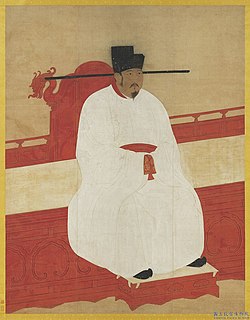Related Research Articles

The Jin dynasty, officially known as the Great Jin, lasted from 1115 to 1234 as one of the last dynasties in Chinese history to predate the Mongol conquest of China. Its name is sometimes written as Kin, Jurchen Jin or Jinn in English to differentiate it from an earlier Jìn dynasty of China whose name is identical when transcribed without tone marker diacritics in the Hanyu Pinyin system for Standard Chinese. It is also sometimes called the "Jurchen dynasty" or the "Jurchen Jin", because its founding leader Aguda was of Wanyan Jurchen descent.

The Five Dynasties and Ten Kingdoms period (907–979) was an era of political upheaval and division in 10th-century Imperial China. Five states quickly succeeded one another in the Central Plain, and more than a dozen concurrent states were established elsewhere, mainly in South China. It was the last prolonged period of multiple political division in Chinese imperial history.

Guangdong is a coastal province in South China on the north shore of South China Sea. The capital of the province is Guangzhou. With a population of 113.46 million across a total area of about 179,800 km2 (69,400 sq mi), Guangdong is the most populous province of China and the 15th-largest by area. Its economy is larger than that of any other province in the nation and the 6th largest sub-national economy in the world with a GDP size of 1.47 trillion US dollars in 2018. The Pearl River Delta Economic Zone, a Chinese megalopolis, is a core for high technology, manufacturing and foreign trade. Located in this zone are two of the four top Chinese cities and the top two Chinese prefecture-level cities by GDP; Guangzhou, the capital of the province, and Shenzhen, the first special economic zone in the country. These two are among the most populous and important cities in China, and have now become two of the world's most populous megacities.

A circuit was a historical political division of China and is a historical and modern administrative unit in Japan. The primary level of administrative division of Korea under the Joseon and in modern North and South Korea employs the same Chinese character as the Chinese and Japanese divisions but, because of its relatively greater importance, is usually translated as province instead.

The Zhuang languages are any of more than a dozen Tai languages spoken by the Zhuang people of Southern China in the province of Guangxi and adjacent parts of Yunnan and Guangdong. The Zhuang languages do not form a monophyletic linguistic unit, as northern and southern Zhuang languages are more closely related to other Tai languages than to each other. Northern Zhuang languages form a dialect continuum with Northern Tai varieties across the provincial border in Guizhou, which are designated as Bouyei, whereas Southern Zhuang languages form another dialect continuum with Central Tai varieties such as Nung, Tay and Caolan in Vietnam. Standard Zhuang is based on the Northern Zhuang dialect of Wuming.
The history of the administrative divisions of the Imperial China is quite complex. Across history, what is called 'China' has taken many shapes, and many political organizations. For various reasons, both the borders and names of political divisions have changed—sometimes to follow topography, sometimes to weaken former states by dividing them, and sometimes to realize a philosophical or historical ideal. For recent times, the number of recorded tiny changes is quite large; by contrast, the lack of clear, trustworthy data for ancient times forces historians and geographers to draw approximate borders for respective divisions. But thanks to imperial records and geographic descriptions, political divisions may often be redrawn with some precision. Natural changes, such as changes in a river's course, or loss of data, still make this issue difficult for ancient times.

Emperor Yingzong of Song, personal name Zhao Shu, was the fifth emperor of the Song dynasty in China. His original personal name was Zhao Zongshi but it was changed to "Zhao Shu" in 1062 by imperial decree. He reigned from 1063 to his death in 1067. He was succeeded by his eldest son, Emperor Shenzong.

Wenshan Zhuang and Miao Autonomous Prefecture is an autonomous prefecture in southeastern Yunnan province, People's Republic of China, and the easternmost prefecture-level division of the province. It borders Baise, Guangxi to the east, Vietnam's Hà Giang Province to the south for 438 kilometres (272 mi), Honghe Hani and Yi Autonomous Prefecture to the west, and Qujing to the north.

The Song dynasty of China was a ruling dynasty that controlled China proper and southern China from the middle of the 10th century into the last quarter of the 13th century. The dynasty was established by Emperor Taizu of Song with his usurpation of the throne of Later Zhou, ending the Five Dynasties and Ten Kingdoms period.

Shi Guangnan was a Chinese composer, best known for his patriotic and nationalistic songs from the Cultural Revolution era that combined traditional melodies with westernized accompaniment.
Bugan, Bogan, Pakan, or Bugeng is an Austroasiatic language. The existence of the Bugan language was not known by the rest of world until recently. There are about 3000 speakers, mostly in some villages in southern Guangnan (广南) and northern Xichou (西畴), Yunnan Province, China. Bugan is an analytic language, and word order and auxiliary words have important functions in the grammar.

Guangnan County is located in Wenshan Zhuang and Miao Autonomous Prefecture, Yunnan province, China. The seat of Guangnan, known today as Liancheng (莲城镇), was the heart of the Gouding Kingdom (句町) that lasted approximately 400 years, from 111 BC to 316 AD.

Nong Zhuang is a Tai language spoken in Wenshan Prefecture, Yunnan, China. In Wenshan Prefecture, it is spoken in Yanshan, Guangnan, Wenshan, Maguan, Funing, Xichou, and Malipo counties, and also in Honghe Prefecture and Vietnam. The heaviest concentrations relative to other Zhuang groups are in Xichou and Malipo counties.
The Zhuang have a rich variety of customs and culture.

Guangxi, officially the Guangxi Zhuang Autonomous Region (GZAR), is an autonomous region of the People's Republic of China, located in South China and bordering Vietnam and the Gulf of Tonkin. Formerly a province, Guangxi became an autonomous region in 1958. Its current capital is Nanning.

The Gouding (句町) Kingdom lasted approximately 400 years, from 111 BC to 316 AD, and was centered on Guangnan County in modern Wenshan Zhuang and Miao Autonomous Prefecture, Yunnan province, China.

Guangnan East Circuit or Guangnan East Province was one of the major circuits during the Song dynasty. Its administrative area corresponds to roughly the modern Chinese province of Guangdong.

Guangnan West Circuit or Guangnan West Province was one of the major circuits during the Song dynasty. Its administrative area corresponds to roughly the modern provinces of Guangxi and Hainan, as well as the western part of Guangdong.

The Lý–Song War was a significant war fought between the Lý dynasty of Đại Việt and the Song dynasty of China between 1075 and 1077. The war began in 1075 when the Lý emperor ordered a preemptive invasion of the Song dynasty using more than 100,000 soldiers, where Đại Việt's forces defeated the Song army and razed the city of Yongzhou to the ground after a forty-two day siege. In response, in 1076 the Song led an army of over 300,000 to invade Đại Việt and by 1077 nearly reached Thăng Long, the capital of Đại Việt, before being halted by general Lý Thường Kiệt at the Nhu Nguyệt River in modern Bắc Ninh Province. After a long battle at the river with high casualties on both sides, Lý Thường Kiệt offered peace to the Song, and the Song commander Guo Kui agreed to withdraw his troops, ending the war.

Jiangzhe province (江浙行省) was a province of the Yuan dynasty established in 1276. It included the southern portion of Jiangsu south of the Yangtze River, Zhejiang, Fujian and part of northern Guangdong. The capital was Hangzhou Lu.
References
- Shi Weile, ed. (2005). Zhongguo Lishi Diming Da Cidian (中国历史地名大词典)[Large Dictionary of Chinese Historical Place Names] (in Chinese). China Social Sciences Press. pp. 227–28. ISBN 7-5004-4929-1.
| This Chinese location article is a stub. You can help Wikipedia by expanding it. |
| This article related to the history of China is a stub. You can help Wikipedia by expanding it. |